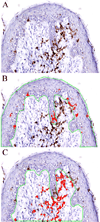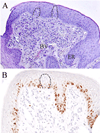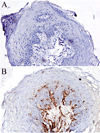Immune cells of the human peripheral taste system: dominant dendritic cells and CD4 T cells
- PMID: 19268521
- PMCID: PMC2730635
- DOI: 10.1016/j.bbi.2009.02.016
Immune cells of the human peripheral taste system: dominant dendritic cells and CD4 T cells
Abstract
Taste loss or alterations can seriously impact health and quality of life due to the resulting negative influence on eating habits and nutrition. Infection and inflammation are thought to be some of the most common causes of taste perception disorders. Supporting this view, neuro-immune interactions in the peripheral gustatory system have been identified, underlying the importance of this tissue in mucosal immunity, but we have little understanding of how these interactions influence taste perception directly or indirectly. This limited understanding is evident by the lack of even a basic knowledge of the resident immune cell populations in or near taste tissues. The present study characterized the distribution and population of the major immune cells and their subsets in healthy human anterior, lingual, fungiform papillae (FP) using immunohistochemistry. Dendritic cells (DCs) were the predominant innate immune cells in this tissue, including four subtypes: CD11c(+) DCs, DC-SIGN+ immature DCs, CD83(+) mature DCs, and CD1a(+) DCs (Langerhans cells). While most DCs were localized beneath the lamina propria and only moderately in the epithelium, CD1a(+) Langerhans cells were exclusively present within the epithelium and not in sub-strata. A small number of macrophages were observed. T lymphocytes were present throughout the FP with CD4(+) T cells more prevalent than CD8(+) T cells. Very few CD19(+) B lymphocytes were detected. The results show that DCs, macrophages, and T lymphocytes are the constitutive guardians of human FP taste tissue, with DCs and CD4 T cells being dominant, while B lymphocytes are rare under normal, healthy conditions. These observations provide a basic anatomical foundation for the immune response in the healthy human tongue as a basis for subsequent disease-related studies, but none of the present data indicate that the immune cell populations identified are, in fact, altered in individuals with abnormal taste perception.
Figures






Similar articles
-
The T cells in peripheral taste tissue of healthy human adults: predominant memory T cells and Th-1 cells.Chem Senses. 2010 Jul;35(6):501-9. doi: 10.1093/chemse/bjq040. Epub 2010 May 9. Chem Senses. 2010. PMID: 20457570 Free PMC article.
-
Mature dendritic cells make clusters with T cells in the invasive margin of colorectal carcinoma.J Pathol. 2002 Jan;196(1):37-43. doi: 10.1002/path.1018. J Pathol. 2002. PMID: 11748640
-
Mapping of the lingual immune system reveals the presence of both regulatory and effector CD4+ T cells.Clin Exp Allergy. 2009 Dec;39(12):1910-9. doi: 10.1111/j.1365-2222.2009.03337.x. Epub 2009 Aug 20. Clin Exp Allergy. 2009. PMID: 19694757
-
CD83: a regulatory molecule of the immune system with great potential for therapeutic application.J Med Dent Sci. 2006 Jun;53(2):85-91. J Med Dent Sci. 2006. PMID: 16913569 Review.
-
Role of CD83 in the immunomodulation of dendritic cells.Int Arch Allergy Immunol. 2002 Oct;129(2):113-8. doi: 10.1159/000065883. Int Arch Allergy Immunol. 2002. PMID: 12403928 Review.
Cited by
-
Dendritic cell dysfunction and diabetic sensory neuropathy in the cornea.J Clin Invest. 2016 May 2;126(5):1998-2011. doi: 10.1172/JCI85097. Epub 2016 Apr 11. J Clin Invest. 2016. PMID: 27064280 Free PMC article.
-
Tongue immune compartment analysis reveals spatial macrophage heterogeneity.Elife. 2022 Jun 24;11:e77490. doi: 10.7554/eLife.77490. Elife. 2022. PMID: 35749158 Free PMC article.
-
Sublingual Immunotherapy: How Sublingual Allergen Administration Heals Allergic Diseases; Current Perspective about the Mode of Action.Pathogens. 2021 Feb 2;10(2):147. doi: 10.3390/pathogens10020147. Pathogens. 2021. PMID: 33540540 Free PMC article. Review.
-
Physiology of the tongue with emphasis on taste transduction.Physiol Rev. 2023 Apr 1;103(2):1193-1246. doi: 10.1152/physrev.00012.2022. Epub 2022 Nov 24. Physiol Rev. 2023. PMID: 36422992 Free PMC article. Review.
-
Human cytomegalovirus infection of langerhans-type dendritic cells does not require the presence of the gH/gL/UL128-131A complex and is blocked after nuclear deposition of viral genomes in immature cells.J Virol. 2014 Jan;88(1):403-16. doi: 10.1128/JVI.03062-13. Epub 2013 Oct 23. J Virol. 2014. PMID: 24155395 Free PMC article.
References
-
- Abdollahi M, Radfar M. A review of drug-induced oral reactions. J Contemp Dent Pract. 2003;4:10–31. - PubMed
-
- Allam JP, Niederhagen B, Bucheler M, Appel T, Betten H, Bieber T, Berge S, Novak N. Comparative analysis of nasal and oral mucosa dendritic cells. Allergy. 2006;61:166–172. - PubMed
-
- Allam JP, Novak N, Fuchs C, Asen S, Berge S, Appel T, Geiger E, Kochan JP, Bieber T. Characterization of dendritic cells from human oral mucosa: a new Langerhans' cell type with high constitutive FcepsilonRI expression. J Allergy Clin Immunol. 2003;112:141–148. - PubMed
-
- Banchereau J, Steinman RM. Dendritic cells and the control of immunity. Nature. 1998;392:245–252. - PubMed
-
- Cavallin MA, McCluskey LP. Lipopolysaccharide-induced up-regulation of activated macrophages in the degenerating taste system. J Neurosci Res. 2005;80:75–84. - PubMed
Publication types
MeSH terms
Substances
Grants and funding
LinkOut - more resources
Full Text Sources
Research Materials

